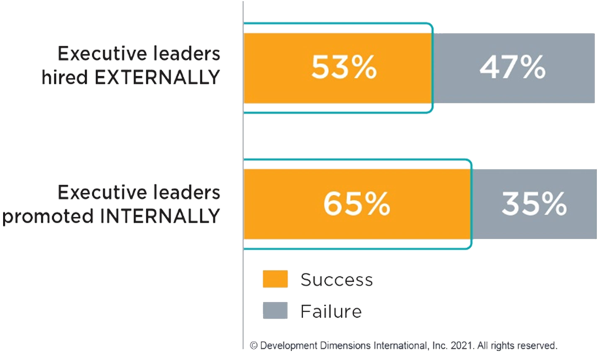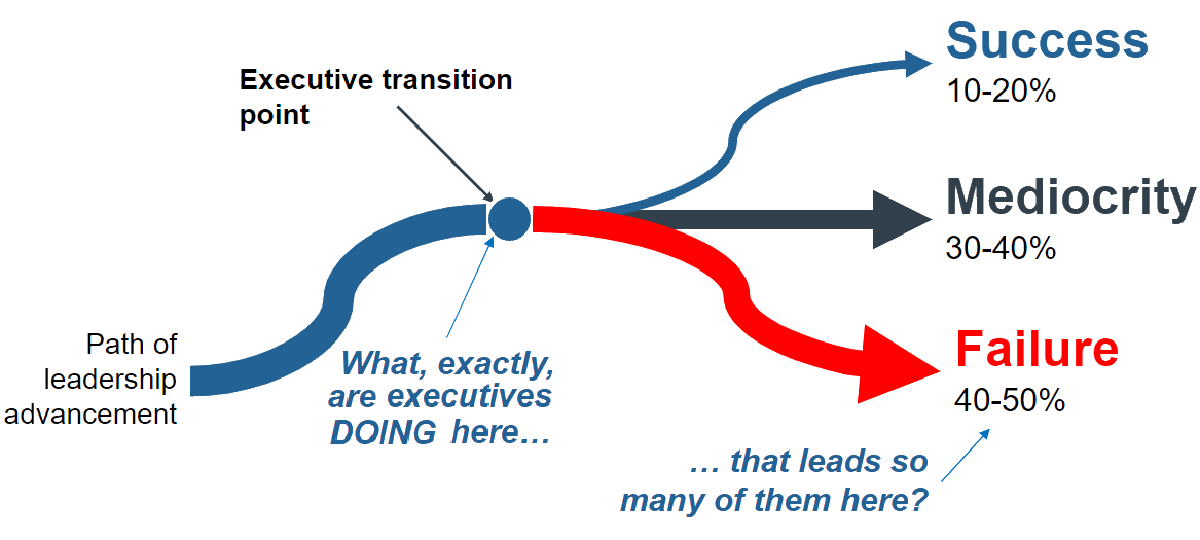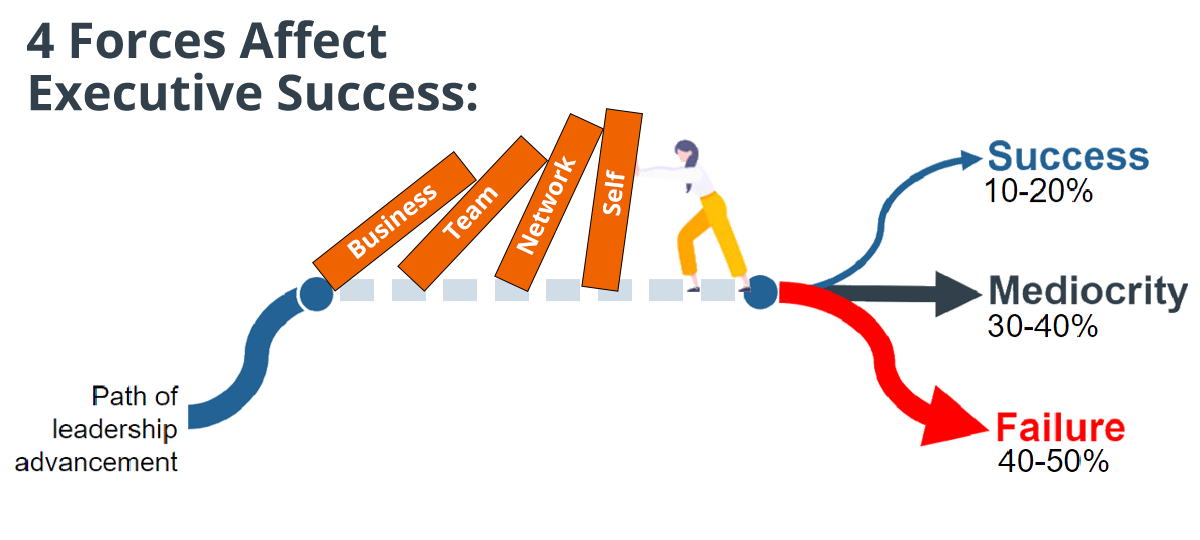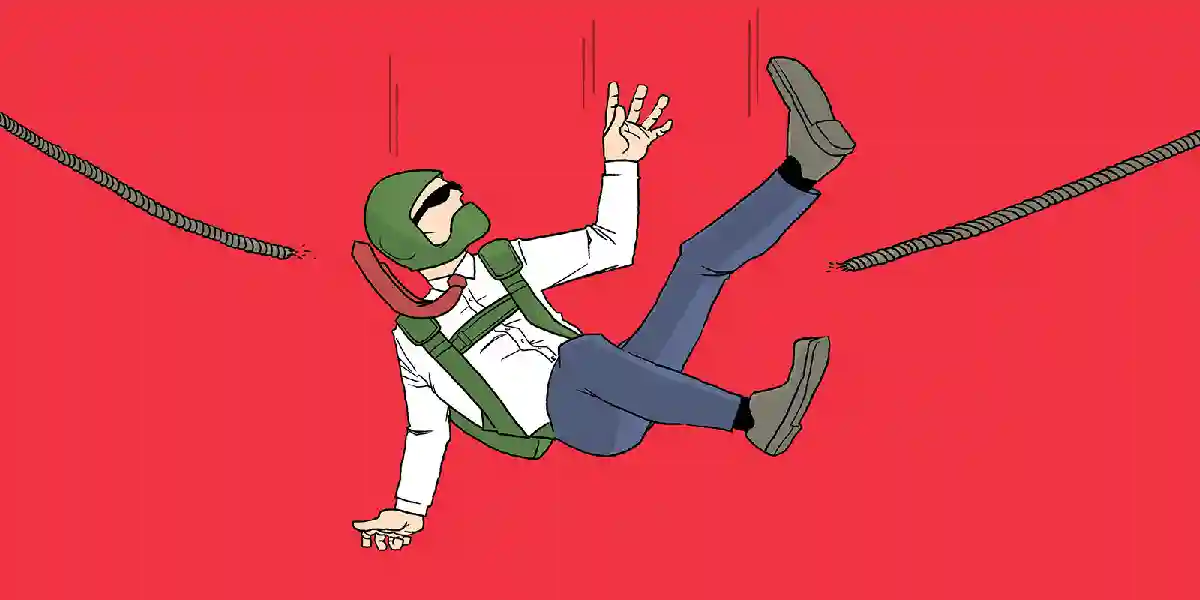
Ever wonder why executives fail in such high numbers?
According to DDI’s Leadership Transitions Report, HR considers about half of executives hired outside to be failures in their roles. The numbers look a little better for internally promoted executives, but more than a third are still failing.

It’s a mystifying statistic. Most people get to this level because they are good at their jobs and care deeply about their careers. So what’s happening behind the scenes that causes them to fail, especially in such high numbers?
But perhaps the bigger question is how much are these failures costing your organization, especially as people in key roles lead the company in the wrong direction?
Understanding the Pressures Every Executive Faces
Every executive faces intense leadership pressure to:
- Lead the business at a more strategic and complex level.
- Lead larger and more diverse teams, requiring more varied people skills.
- Lead across broader networks, which mandates more forethought and proactivity.
- Lead themselves, which demands deeper introspection, self-awareness, and adaptation.

These pressures are always present, but different areas tend to become more acute at certain times.
But what matters more is how executives handle these pressures. Somehow, the same challenges cause executives to trip, one after the next, including leaders with strong skills and track records. Every individual deals with these pressures differently depending on their personal tendencies as well as the relative strength or weakness of their skills.
5 Reasons Why Smart Executives Fail
With these pressures in mind, our team of executive coaches has seen some common patterns in why smart executives fail:

1. They struggle with the ambiguity of senior leadership.
Most senior leaders are promoted because they have excelled in operational roles. They are diligent, conscientious, and get things done on time. And they thrive on being in the thick of execution—leading a team, but still entrenched in day-to-day decisions and tactics.
But those same skills that led to success in the past lead to failure at the executive level.
While in previous roles they’ve often worked from a playbook or operations guide, new executives now need to create their own playbook, despite having little or no experience. They also haven’t experienced making decisions in an environment that’s much more complex, uncertain, and faster-paced.
How can new executives learn to lead amid ambiguity? It can start with how they inspire and help their teams and fellow stakeholders deal with uncertainty and complexity.
Ambiguous environments can sometimes be the launchpad for new ideas, fresh thinking, and growth. Great executive leaders leverage ambiguous situations and environments as opportunities to practice uncomfortable behaviors. These behaviors include accepting the personal risk of being wrong when making decisions, trying a new approach when success is uncertain, and speculating on new ventures or concepts even before they’re needed or wanted.

2. They focus on micromanaging rather than strategic vision.
As an executive, success comes to those who can effectively step away from managing the day to day. Trusting their operational leaders—now their direct reports—to handle these responsibilities allows them to focus on the bigger, more strategic picture of the business.
Executives who allow themselves to get pulled into technical responsibilities run into two problems:
- Operational leaders become disengaged when they lack opportunities to express their creativity and make unique contributions.
- They hinder their operational leaders’ growth by denying them opportunities to build judgment and decision-making skills through experimentation and failure.
Effective strategic leaders spend the time necessary to create a vivid picture of a preferred future. And—this is of critical importance—they describe that future explicitly so others can “see” it.
Effective strategic leaders are also able to cultivate the relationships required to create a road map and enablers for achieving that vision.

3. They stumble when influencing a broader stakeholder network.
Most new executives have climbed the ladder on the strength of their superior technical skills and expertise. But once in the executive role, it surprises them that their technical prowess alone is not enough to convince fellow executives that work needs to be done; rather, they need to influence them to gain their buy-in and, more importantly, their commitment.
New executives can learn to influence others by packaging their ideas to capture the hearts and minds of their audience. They can do this by:
- Identifying, assessing, and prioritizing influence opportunities and choosing strategies that will aid in advancing the most pressing business objectives.
- Building influence strategies based on what they know about the motivations, needs, and concerns of those they need to influence.
- Evaluating their business network and building supportive and reciprocal long-term working relationships at all levels of the organization.

4. They exhibit overconfidence and a lack of introspection.
Confidence is crucial to inspiring a team. But many executives don’t have an accurate picture of their own strengths and weaknesses, especially if they haven’t been through an executive leadership assessment. As a result, they may be overconfident in the wrong places.
Overconfidence can sometimes be perceived by others as arrogance. An arrogant executive “talks at” their team and stops listening to other perspectives (because they truly believe they are smarter than everyone else in the organization), which can destroy the valuable relationships a leader needs to be effective.
Arrogant executives are quick to celebrate their own accomplishments but may forget to share praise and recognition when their teams are successful. Because of this, their teams start to root against them and often lack the motivation to follow them.
Worse, they often lack the self-awareness and introspection to realize that they’re doing this. In their eyes, they are displaying appropriate confidence. Without an executive feedback process, they have no idea how others are perceiving them.
As one executive put it, “Your personality is going to become public, whether you like it or not. The question is: what impact is it having, and what do you need to do about it?”

5. They face the pressures of rapid change.
Amid all of these other pressures, change is happening at a faster rate than ever. For many executives, it feels like every time they start to get their footing, the rug is pulled out from under them.
Prior to their executive roles, many business leaders may not have been responsible for initiating change or setting the tone for their teams during transitions. While employees at all levels feel the effects of change, executive leaders face the unique challenge of taking the lead in uncertainty, shaping strategies, and guiding their teams through it.
It’s crucial for new executives to have the skills to guide themselves, their employees, and their organizations through the rough waters brought on by continuous change. They need to be adaptable and have the ability to stay focused, manage stress, and take decisive action—despite a lack of definitive information. Executives who lead through change effectively create a stable environment for the rest of the organization to continue to hum, even when there’s still some ambiguity at the top.
Recognize the Signs of Executive Failure
By understanding the pressures at play behind the scenes you can better identify how they surface in an executive’s work. Once you know how to spot these pitfalls early, you can stop executives from getting in so deep they can’t reverse course. Better yet, you may prevent executives from stumbling at all.
Our team has a large set of pitfalls we’ve collected from our executive coaching experience over the years, especially our unique Pressure PointSM Development for executives. Here are a few of the most common pitfalls.
Pitfall #1: Unfiltered Focus
What it is: The magnitude of going from managing 30 people to 200 is huge. Suddenly, a lot more people are asking for time, attention, and resources. Wanting to build good relationships and find early success, the typical executive says “yes” to too many things. But down the road, too many priorities cause a lack of focus. While executives and their teams work to make progress on everything, they don’t make significant progress on anything.
How to recognize it: Usually you’ll see an incredibly busy department, possibly to the point of overload and fatigue. At the same time, very little progress is made on key priorities. They miss deadlines, abandon projects, and frequently fall short.
Causes: Often the cause is too much of a good thing. The executive starts in the role full of excitement and ideas for innovation. But without proper filtering and prioritization, it’s hard to make progress. The executive may also find themselves too deep in the details. Combined with indecisiveness (common among executives in new assignments), it can be a deadly combo.
What to do about it: First, recognize that this is happening. Without support or coaching, many don’t. Second, executives need to prioritize based on what drives value and impact. This may seem obvious, but time and again, our executive coaching efforts result in significant reorganization of priorities and changes in what an executive sees as most important. Executives find great value in breaking down their change efforts into levels of priority based on strategic impact. Doing this with a partner or coach can unfreeze thinking about how to make more meaningful progress, and faster.
Pitfall #2: Network Isolation
What it is: One of the most common reasons why executives fail is their struggle to build and maintain their networks. That doesn’t mean they aren’t good with people. Rather, they are used to operating independently. While that may have worked at lower levels, executives have to think more broadly and proactively about how their work impacts other groups.
How to recognize it: You’ll start to see misalignment and conflicts between groups. Likewise, the executive will see unexpected stakeholder resistance and a lack of advocacy for their team’s projects. One of the trickiest side effects is that they may get a very positive response from their own team, who might be tightly aligned. But that can coincide with low regard for other groups and a reluctance to adopt broader company change.
Causes: One of the major causes is functional bias. Executives often focus on the area where they have expertise and ignore matters that are outside their comfort zone. In addition, people who are more reserved or introverted may hesitate to initiate connections where they need them.
What to do about it: Ensure that executives actively seek exposure to other groups in the business, including their goals and metrics of success. They also need to pay careful attention to being more inclusive in their communication. They should consider pitching plans and ideas to peers to hear their concerns and secure support before moving forward.
Pitfall #3: Un-Coaching
What it is: At lower levels, leaders often coach their teams on more technical matters in their area of expertise. But when they get to the executive level, it’s time to think more broadly about talent. “Un-coaching” happens when executives downplay or miss opportunities to coach, develop, and grow the skills of their team.
How to recognize it: When you see a team that has high turnover—especially unexpected departures of high performers—un-coaching may be occurring. In addition, among those who remain, there’s a high proportion of mediocre performers. You may also see low engagement scores and lagging performance across the department.
Causes: This pitfall happens for a variety of reasons. In many cases, executives adopt a sink-or-swim mindset, and coaching simply doesn’t occur to them as an essential leadership activity. Other executives may lack self-confidence and feel threatened by talented subordinates. Or they may simply fail to see the potential in others because they are preoccupied with their own work. Regardless of the reason, the outcome is stagnation. Teams fail to grow, making them less agile as the business evolves.
What to do about it: The strongest executives make a mental shift away from small-scale, tactical coaching and think instead about developing the broader capabilities of their teams. This means continually searching for opportunities to expand the accountabilities of team members and stretch them into assignments where they can master new skills and make larger business contributions. Ultimately, this is about taking accountability for growing organizational talent, not just coaching in the moment.
Why Executives Fail: The #1 Cause
Our research and experience shows that executives are the leaders most in need of support and the least likely to ask for it. And this helps to explain why the most common cause of executive failure is the absence of support.
Over the last couple of years, we’ve interviewed many human resource executives about what happens when people become executives in their organization. Here are a few direct quotes from what we heard:
- “With the vast majority, it’s ‘Congratulations—now go for it!’ In other words, we do nothing for them.”
- “If they are internal, then nothing. We send out a company-wide announcement about their promotion, change their comp plan, and send them off!"
- “Pretty much nothing—it’s just seen as the next transition up the hierarchy.”
Notice a common theme? Executives most often get nothing from HR to support their transition.
It’s easy to see why executives fail so often. But take a moment to consider the waste. The cost of suboptimizing these mission-critical leaders—in whom you’ve invested for years—is extreme.
But it is also avoidable. Most executive pitfalls are common and predictable. Building awareness and the agility to work around or through these pitfalls is something we help executives do every day. The important thing is not to wait until it’s too late.
Topics covered in this blog

